



알루미늄 질화물 세라믹의 독특한 장점
기존의 알루미나(Al₂O₃) 세라믹과 비교하여, 질화알루미늄(AlN) 세라믹 다음과 같은 독특한 장점을 제공합니다.
AlN의 가장 큰 장점은 매우 높은 열전도도입니다. 이론값은 320 W/(m·K)에 달하며, 이는 알루미나의 5~10배에 달합니다. 이는 동일한 작동 조건에서 AlN 세라믹이 더 높은 열유속 밀도를 견딜 수 있음을 의미합니다. 패키징 기판 또는 케이싱으로 AlN 세라믹은 고전력 칩이나 모듈의 방열에 특히 유용합니다. AlN 금속-세라믹 발열체로 제작될 경우,AlN 세라믹 히터), 빠른 가열이 가능합니다. 정전 척 (정전기 척)을 사용하면 흡착된 웨이퍼를 빠르게 예열/가열할 수 있습니다.
AlN은 열팽창계수(CTE)가 4.3ppm/K로 매우 낮아 실리콘 칩(3.5~4.0ppm/K)과 유사합니다. 이는 실리콘 칩과 AlN 세라믹 사이에 자연스럽고 높은 수준의 열팽창 매칭이 이루어짐을 의미하며, 이는 패키징 신뢰성을 본질적으로 향상시킵니다.
또한, AlN 세라믹은 알루미나 세라믹과 비슷한 기계적 특성, 전기적 성능, 내식성을 보입니다.
AlN 세라믹은 높은 열전도도, 낮은 열팽창, 높은 강도, 내화학성 등의 특성을 모두 갖추고 있어, 특히 대규모 집적 회로와 고성능 전자 소자에 응용하기에 이상적인 방열 소재입니다.

AlN 세라믹의 열전도도에 영향을 미치는 요인
AlN 세라믹은 절연체이기 때문에 전자와 광자에 의한 열전달은 거의 영향을 받지 않습니다. AlN 세라믹의 주요 열전달 메커니즘은 포논(격자 진동) 전도입니다. AlN 세라믹의 Al-N 결합은 높은 결합 에너지와 짧은 결합 길이를 가지므로 포논 전파 속도가 빠르며, 이것이 높은 열전도도를 나타냅니다.
AlN의 이론적인 열전도도는 320 W/(m·K)에 달할 수 있지만, 현재 최대 230 W/(m·K)의 열전도도를 가진 AlN 세라믹을 생산할 수 있는 회사는 극소수에 불과합니다. 일반적으로 시판 제품의 실제 열전도도는 150~180 W/(m·K)입니다. AlN 세라믹의 열전도도에 영향을 미치는 요인은 다음과 같습니다.
미시적인 관점에서 볼 때, 결정립계, 계면, 이차상, 결함, 그리고 결정 구조 내의 포논 산란은 모두 포논 전달에 영향을 미칩니다. 실제 경험에 따르면, AlN 세라믹의 열전도도에 영향을 미치는 주요 요인으로는 격자 밀도, 산소 함량, 원료 분말 순도, 그리고 미세 구조가 있습니다.

1. 밀도
밀도가 낮은 샘플은 수많은 기공을 포함하고 있는데, 이는 포논을 산란시키고 평균 자유 행로를 감소시켜 AlN 세라믹의 열전도도를 낮춥니다. 또한, 밀도가 낮은 샘플은 특정 응용 분야의 기계적 성능 요건을 충족하지 못할 수 있습니다.
2. 산소 함량
AlN과 산소 사이의 강한 친화력으로 인해 AlN 표면은 공기나 습기에 노출되면 쉽게 산화되어 알루미나 막을 형성합니다. 이로 인해 알루미늄 결손과 산소 결함이 발생하고, 이는 소결 과정에서 AlN 격자 내로 확산될 수 있습니다. 이러한 결함이 AlN 결정 네트워크 전체로 확산되면 포논의 평균 자유 경로가 감소하여 열전도도가 감소합니다.
3. 격자 결함
연구 결과, AlN(질화알루미늄 세라믹) 격자의 결함 유형은 산소 원자 농도와 관련이 있는 것으로 나타났습니다.
산소 농도가 0.75% 미만이면 산소 원자가 AlN 격자 내에 균일하게 분산되어 질소 원자를 치환하고 알루미늄 공석을 생성합니다.
산소 농도가 0.75% 이상이 되면 AlN 격자 내 알루미늄 원자의 위치가 이동하여 알루미늄 공석이 사라지고 팔면체 결함이 생성됩니다.
산소 농도가 높아지면 격자는 폴리타입, 역 도메인, 산소를 포함하는 적층 결함과 같은 확장된 결함을 발생시킵니다.

AlN 세라믹의 열전도도 향상을 위한 대책
1. 밀도 증가
미세입자의 고소결성 마이크로/나노 분말을 사용하거나, 소결 보조제를 첨가하거나, 고에너지 물리적 보조 소결 방법을 채택하여 세라믹의 소결 밀도를 높입니다.
2. 산소 함량 및 내부 결함 감소
고순도 저산소 원료 분말을 선택하십시오. 원료 분말의 보관 및 반제품 성형 시 습기 노출을 피하십시오. 대기 소결 시 산소 농도를 엄격히 관리하십시오.
에 대한 샤먼 쥐치 테크놀로지
샤먼 쥐치테크놀로지는 선두주자입니다 AlN 분말 그리고 AlN 세라믹 제조 중국에 본사를 두고 있습니다. 당사 제품은 우수한 열전도도, 전기 절연성, 그리고 기계적 강도를 자랑하며, 전자 패키징, 반도체, LED 방열 등 다양한 분야에 널리 사용됩니다. 첨단 제조 공정과 엄격한 품질 관리를 통해 높은 신뢰성을 제공합니다. AlN 기판, 구조적 구성 요소 및 맞춤형 솔루션을 제공하여 첨단 제조 산업을 지원합니다.
미디어 연락처:
샤먼 쥐츠 테크놀로지 유한회사
전화: +86 592 7080230
이메일: miki_huang@chinajuci.com
웹사이트: www.jucialnglobal.com